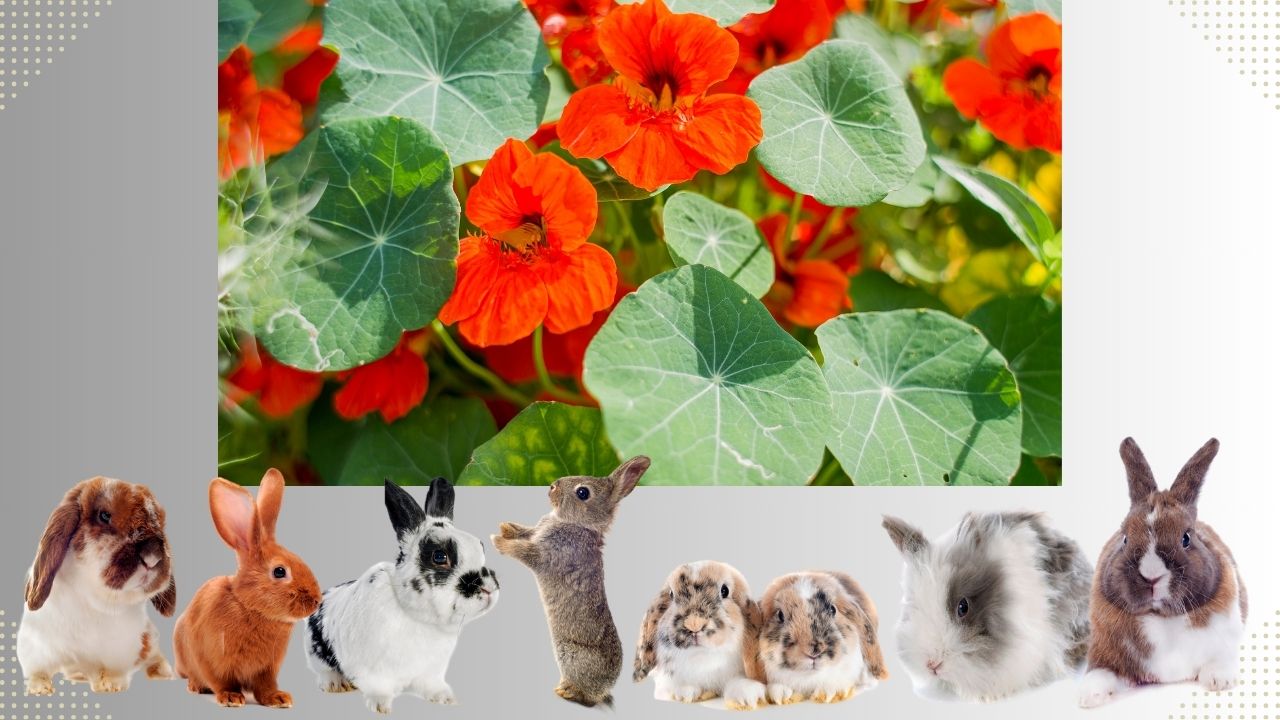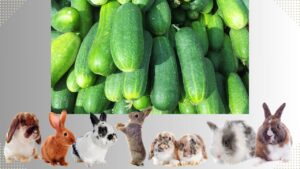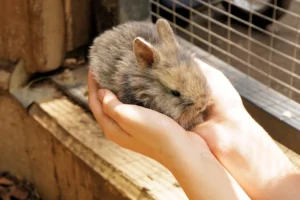Are you wondering if rabbits have a taste for nasturtiums? Well, you’re in the right place! This article will explore the diet of rabbits and their preference for these vibrant flowers.
We’ll delve into the reasons behind their attraction to nasturtiums and how they devour them with gusto.
Additionally, we’ll provide strategies to protect your garden from these furry visitors.
So, let’s dive in and uncover the fascinating rabbit-nasturtium conundrum together!
In This Article
- 1 Key Takeaways
- 2 The Diet of Rabbits: Exploring Their Preference for Nasturtiums
- 3 Nasturtiums: A Delectable Delight for Rabbits
- 4 Understanding the Attraction: Why Rabbits Love Nasturtiums
- 5 Feeding Frenzy: How Rabbits Devour Nasturtiums
- 6 Protecting Your Garden: Strategies to Keep Rabbits Away From Nasturtiums
- 7 Natural Deterrents: Using Plants and Smells to Repel Rabbits From Nasturtiums
- 8 The Rabbit-Nasturtium Conundrum: Finding a Balance Between Wildlife and Garden Beauty
- 9 Frequently Asked Questions
- 9.1 Are Nasturtiums the Only Plant That Rabbits Eat?
- 9.2 Can Rabbits Eat Other Parts of the Nasturtium Plant Besides the Leaves?
- 9.3 What Are Some Other Plants That Rabbits Find Attractive?
- 9.4 How Can I Protect My Other Garden Plants From Rabbits?
- 9.5 What Are the Benefits of Having Rabbits in My Garden, Despite Their Attraction to Nasturtiums?
- 10 Conclusion
Key Takeaways
- Rabbits have a preference for nasturtiums due to their attractive foliage, vibrant flowers, and peppery taste.
- Nasturtiums are a nutritious addition to a rabbit’s diet, providing vitamins, minerals, and beneficial compounds.
- It’s important to ensure that rabbits have a balanced diet and not rely solely on nasturtiums.
- Strategies such as fencing, natural repellents, and providing alternative food sources can protect gardens from rabbit damage.
The Diet of Rabbits: Exploring Their Preference for Nasturtiums
You should explore the preference of rabbits for nasturtiums in their diet.
Nasturtiums (Tropaeolum majus) are a flowering plant belonging to the family Tropaeolaceae. They’re known for their vibrant orange, yellow, and red flowers, which aren’t only visually appealing but also have a unique flavor.
Rabbits have been observed to show a particular fondness for nasturtiums, including both the leaves and flowers. The leaves of the nasturtium plant are rich in vitamins and minerals, making them a nutritious addition to a rabbit’s diet. Additionally, rabbits are attracted to the peppery taste of nasturtiums, which adds variety to their palate.
These plants can be grown easily in gardens or pots, providing a sustainable food source for rabbits while also adding beauty to the surroundings. However, it’s important to ensure that rabbits have a balanced diet and not rely solely on nasturtiums.
Nasturtiums: A Delectable Delight for Rabbits
Rabbits relish the taste of nasturtiums, eagerly devouring the vibrant flowers and nutritious leaves. Nasturtiums, scientifically known as Tropaeolum majus, are a delightful delicacy for these furry creatures.
Rabbits exhibit a natural behavior of foraging, and their preference for nasturtiums is evident in their enthusiastic consumption of both the flowers and leaves. The succulent flowers with their vivid hues and distinct shape provide visual appeal to rabbits, while the leaves offer a nutritious treat.
Nasturtiums are rich in vitamin C and contain beneficial compounds such as glucosinolates and flavonoids. These compounds contribute to the overall health and well-being of rabbits, promoting a strong immune system and aiding in digestion.
While nasturtiums are a favored food for rabbits, it’s important to provide a varied diet to ensure their nutritional needs are met. Offering alternative rabbit delicacies such as kale, parsley, or dandelion greens can provide a well-balanced and satisfying diet for these furry friends.
Understanding the Attraction: Why Rabbits Love Nasturtiums
Have you ever wondered about the reasons behind rabbits’ strong affinity for nasturtiums? Understanding the attraction between rabbits and nasturtiums can provide valuable insights for gardeners looking to attract wildlife.
Nasturtiums, scientifically known as Tropaeolum majus, are a popular choice for rabbits due to their attractive foliage and vibrant flowers. These plants have long trailing stems and rounded leaves that provide rabbits with ample hiding spots and shelter. Additionally, rabbits are attracted to the peppery taste and strong aroma of nasturtium leaves and flowers.
Gardeners can take advantage of this by strategically planting nasturtiums in their gardens to attract rabbits and encourage wildlife biodiversity. To further enhance the rabbit-friendly environment, gardeners can also provide additional food sources, such as clover or dandelions, and create sheltered areas with low-growing plants.
These gardening tips can help create a harmonious space where rabbits and other wildlife can thrive.
Feeding Frenzy: How Rabbits Devour Nasturtiums
While it may seem surprising, the way rabbits devour nasturtiums during a feeding frenzy is truly remarkable. These furry creatures exhibit an interesting behavior when it comes to consuming these vibrant flowers. Let’s delve into the world of rabbits and explore their behavior in relation to the nutritional value of nasturtiums.
- Rabbits have a keen instinct for identifying plants that are rich in nutrients, and nasturtiums are no exception. These flowering plants are packed with vitamins and minerals, making them an attractive food source for rabbits seeking a balanced diet.
- During a feeding frenzy, rabbits display their remarkable ability to quickly and efficiently consume nasturtiums. With their sharp incisors, they expertly graze on the leaves, stems, and even flowers of these plants. Their nibbling action ensures a thorough consumption of the plant parts.
- Nasturtiums provide rabbits with essential nutrients such as vitamin C, beta-carotene, and antioxidants. These beneficial compounds contribute to their overall health and well-being, strengthening their immune system and promoting optimal growth.
Protecting Your Garden: Strategies to Keep Rabbits Away From Nasturtiums
To keep rabbits away from your precious nasturtiums, try using a combination of fencing and repellents. Rabbits are known to be voracious eaters and can quickly decimate your garden if not properly protected. Fencing is an effective method to physically prevent rabbits from accessing your plants. Use a sturdy wire mesh with small openings to keep them out. Additionally, natural repellents can be used to deter rabbits from approaching your nasturtiums. These repellents often contain strong scents or tastes that rabbits find unpleasant. Planting garlic, onions, or marigolds around your nasturtiums can help repel rabbits due to their strong odor. You can also try spraying a mixture of water and cayenne pepper onto the leaves of your plants. Remember to reapply the repellents after rainfall or as needed. By implementing these strategies, you can protect your garden and enjoy the beauty of your nasturtiums without worrying about rabbit damage.
| Natural Repellents | Description |
|---|---|
| Garlic | Strong odor that repels rabbits |
| Onions | Strong scent that rabbits find unpleasant |
| Marigolds | Produces a smell that deters rabbits |
| Cayenne pepper | Spraying a mixture of water and cayenne pepper onto plants can deter rabbits |
Natural Deterrents: Using Plants and Smells to Repel Rabbits From Nasturtiums
You can repel rabbits from your nasturtiums by using plants with strong scents, such as garlic or marigolds, and spraying a mixture of water and cayenne pepper onto the leaves. Companion planting is a strategy that involves growing certain plants together to benefit each other.
Here are three key points to consider when using scent and companion planting to repel rabbits from your nasturtiums:
- Choose plants with strong scents: Garlic (Allium sativum) and marigolds (Tagetes spp.) emit strong odors that can deter rabbits. Plant them near your nasturtiums to create a barrier of scents that rabbits find unpleasant.
- Spray a mixture of water and cayenne pepper: Create a solution by mixing water and cayenne pepper powder. Spray this mixture onto the leaves of your nasturtiums to make them less appealing to rabbits. The strong scent and taste of the pepper can act as a deterrent.
- Rotate companion plants: Rabbits may become accustomed to certain scents over time. To maintain their effectiveness, rotate companion plants with strong scents every season. This prevents rabbits from adapting and reduces the risk of them developing a tolerance to the scents.
The Rabbit-Nasturtium Conundrum: Finding a Balance Between Wildlife and Garden Beauty
Your garden’s beauty and the well-being of wildlife can coexist harmoniously in the rabbit-nasturtium conundrum. Nasturtiums (Tropaeolum majus) are beautiful flowering plants that add vibrant color to any garden. However, they’re also a favorite food of rabbits (Oryctolagus cuniculus), which can pose a challenge for wildlife preservation and garden aesthetics.
To find a balance, it’s important to understand the habits and preferences of both rabbits and nasturtiums. Rabbits are herbivores that enjoy feeding on the tender leaves and flowers of plants. Nasturtiums, with their succulent foliage and bright blossoms, are particularly enticing to these furry creatures.
To protect your garden while still supporting wildlife, consider implementing the following strategies:
- Plant repellent companion plants: Interplanting nasturtiums with strong-smelling herbs like rosemary or lavender can deter rabbits from feasting on them.
- Use physical barriers: Erecting a fence or installing wire mesh around your garden can prevent rabbits from accessing the plants.
- Provide alternative food sources: Planting rabbit-friendly food such as clover or dandelions in another area of your garden can divert their attention away from the precious nasturtiums.
Frequently Asked Questions
Are Nasturtiums the Only Plant That Rabbits Eat?
Rabbits have diverse dietary preferences beyond just nasturtiums. While these plants offer some benefits, rabbits consume a variety of plant parts, such as leaves and stems, depending on their food preferences.
Can Rabbits Eat Other Parts of the Nasturtium Plant Besides the Leaves?
Rabbits can eat all parts of the nasturtium plant, including the flowers and stems, not just the leaves. However, it’s important to note that rabbits may have preferences and some individual rabbits may not be interested in certain parts.
What Are Some Other Plants That Rabbits Find Attractive?
Rabbits find certain plants attractive. To protect your garden, choose rabbit-proof plants such as lavender, rosemary, and marigolds. These plants have characteristics that rabbits dislike, making them less likely to be eaten.
How Can I Protect My Other Garden Plants From Rabbits?
To protect your garden plants from rabbits, you can use rabbit deterrents such as fences, repellent sprays, or planting rabbit-resistant species. These methods will help ensure the safety and growth of your plants.
What Are the Benefits of Having Rabbits in My Garden, Despite Their Attraction to Nasturtiums?
Having rabbits in your garden can have several benefits, such as natural pest control and fertilizer. To protect your other garden plants from rabbits, you can rabbit-proof them by using fences or repellents.
Conclusion
In conclusion, rabbits have a strong preference for nasturtiums due to their delectable taste and attractive characteristics. The feeding frenzy that rabbits engage in when devouring nasturtiums can be problematic for gardeners, requiring the implementation of strategies to protect their gardens.
Natural deterrents, such as specific plants and smells, can be effective in repelling rabbits from nasturtiums. Finding a balance between wildlife and garden beauty is a conundrum that gardeners must navigate.





